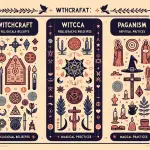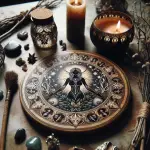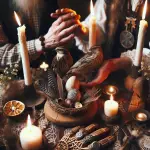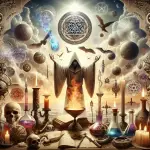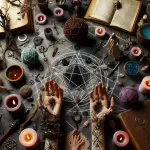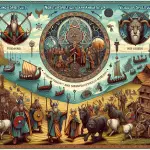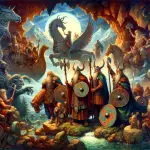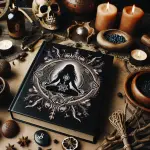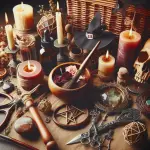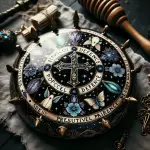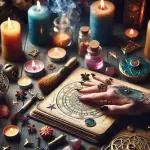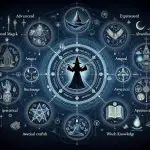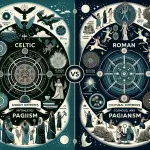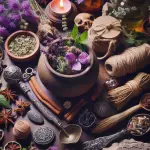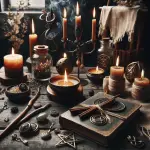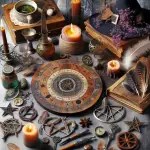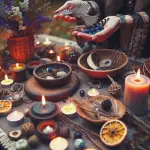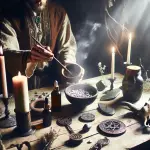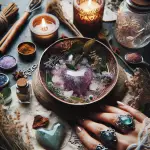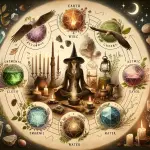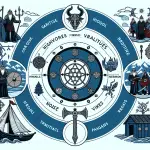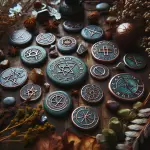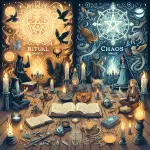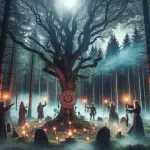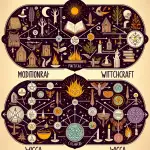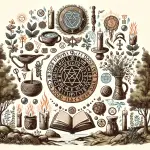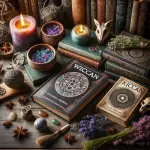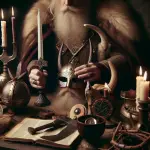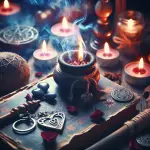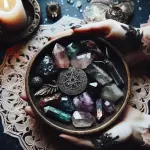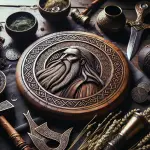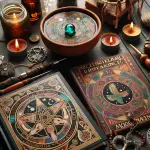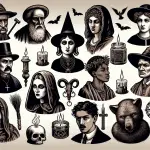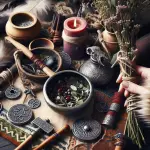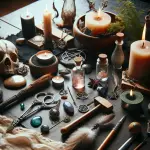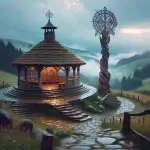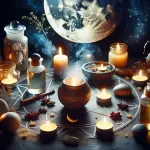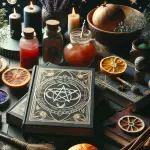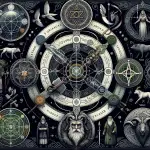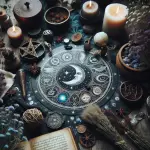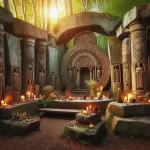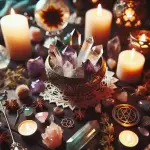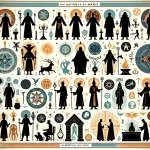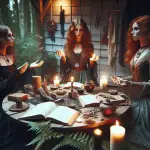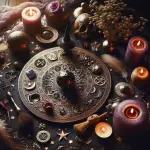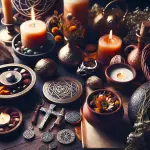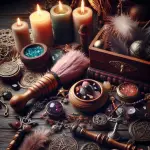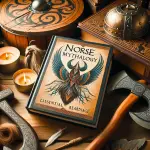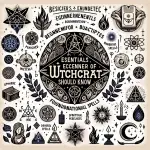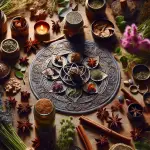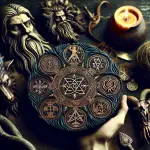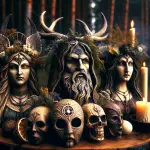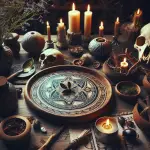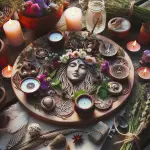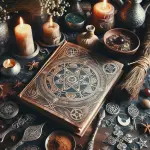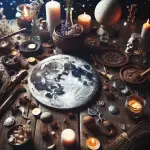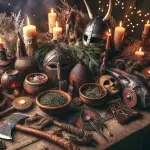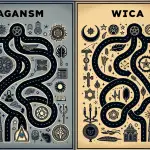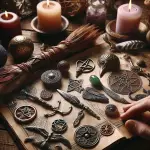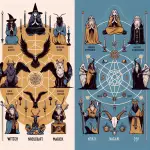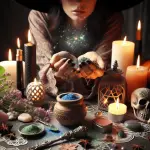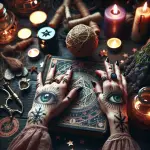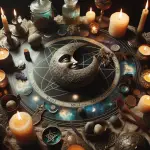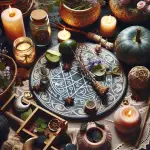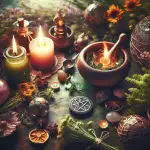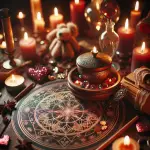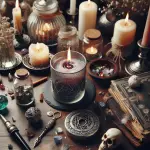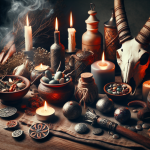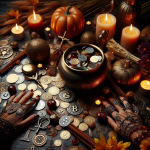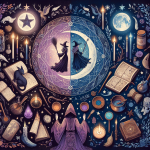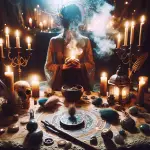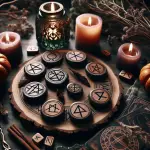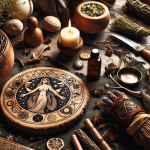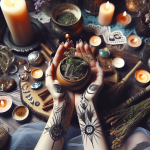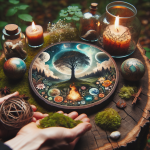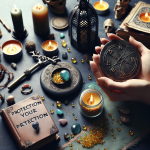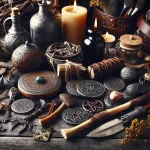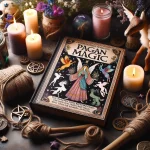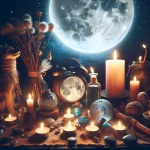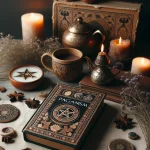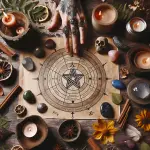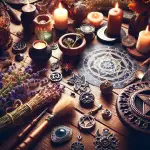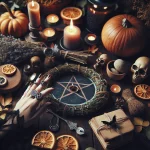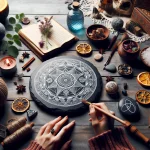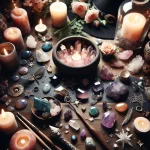Home – Witchcraft For Beginners
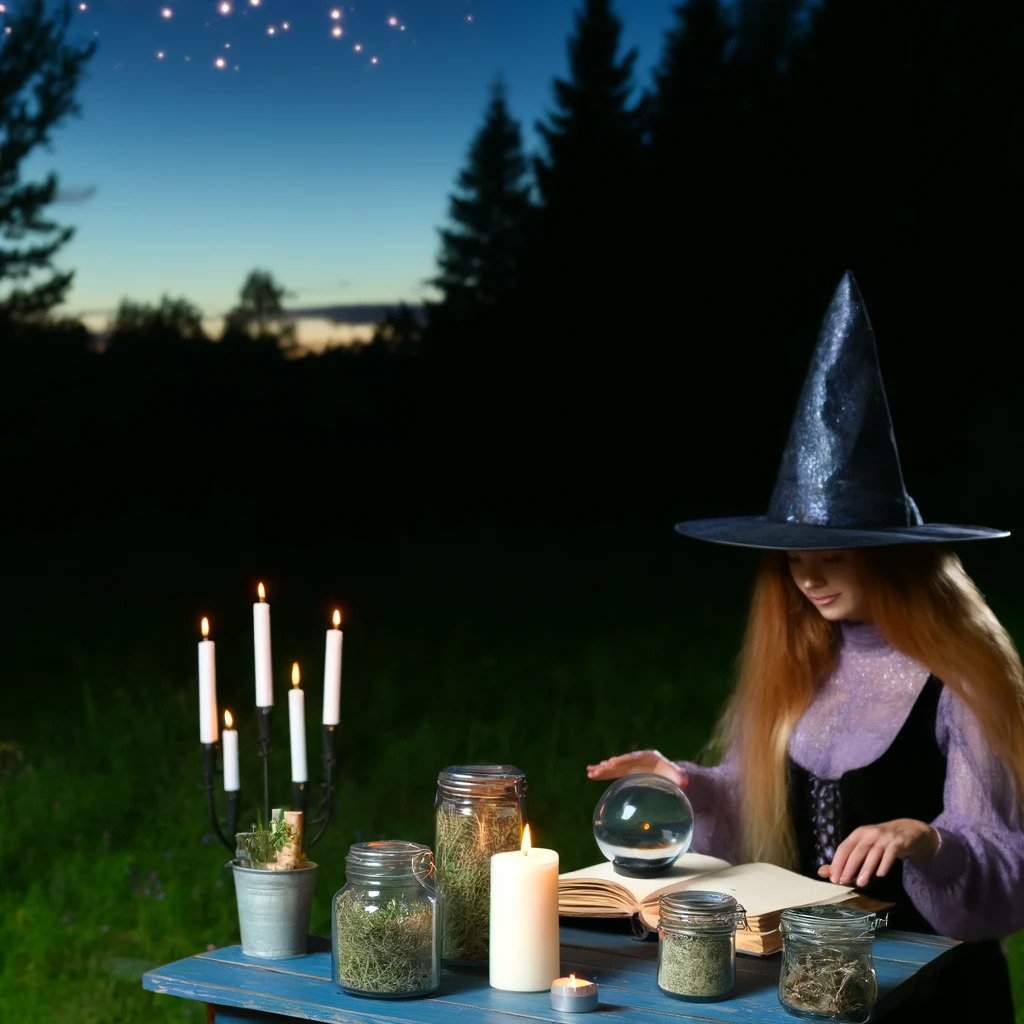
As an Amazon Associate I earn from qualifying purchases.
Witchcraft for Beginners: Unveil Mystical Secrets!
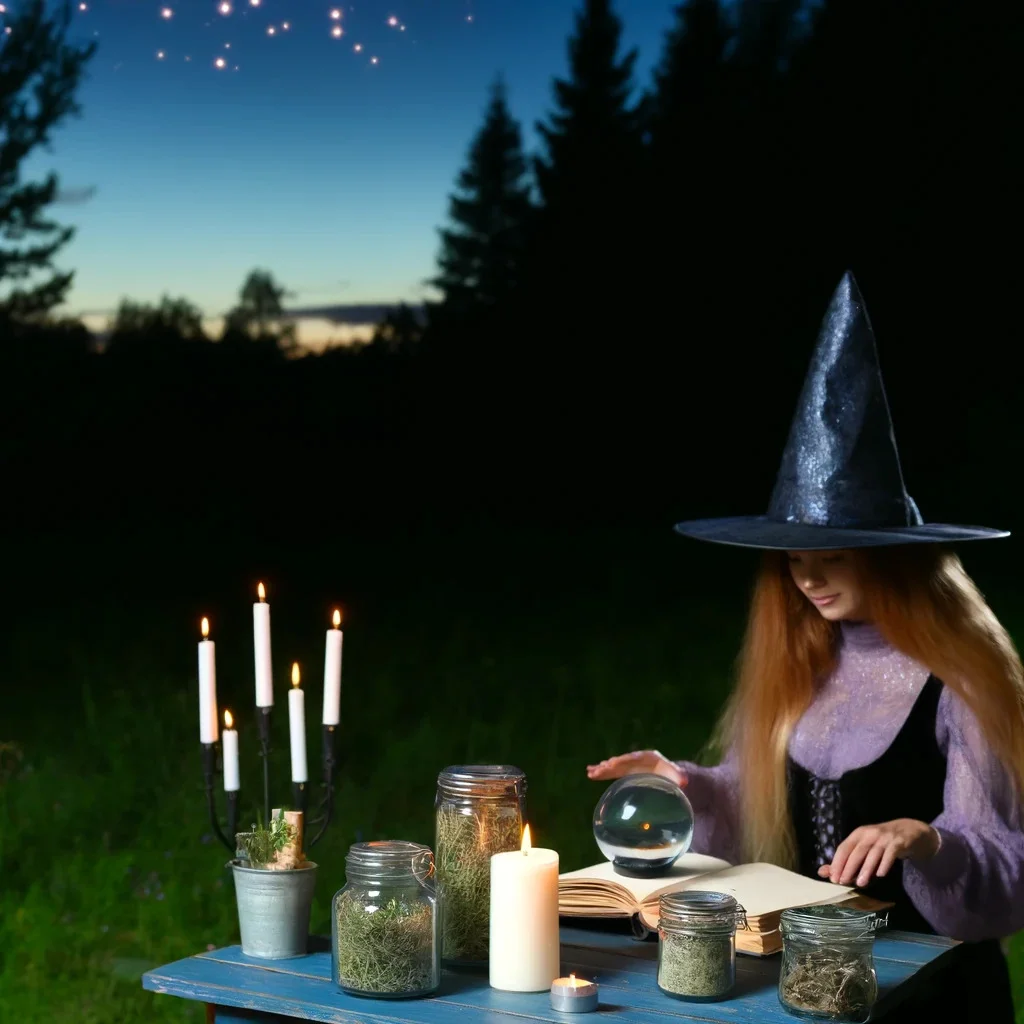
Witchcraft for beginners involves understanding its history and learning basic practices. Start with core concepts like rituals, witchcraft spells, and energy work.
Embarking on the path of witchcraft can be both exhilarating and daunting. This ancient practice, rich with traditions and diverse in expression, often calls to those seeking a deeper connection with the natural world and its energies. Beginners should focus on foundational knowledge, which includes the significance of elements, phases of the moon, and the importance of intention in spellcasting.
Learning the basics of witchcraft for beginners can be overwhelming at first. But We will show you some witchcraft books for beginners that help make everything easier
Aspiring witches are encouraged to cultivate their intuition and develop their unique craft through study, meditation, and practice. With an emphasis on respect for nature and ethical considerations, newcomers can explore this spiritual journey with mindfulness and an open heart. Starting with simple spells and rituals, you can integrate witchcraft into daily life, unlocking a world where magic weaves through the fabric of reality. Remember, patience and persistence are key as you step into the realm of the mystical and embrace the enchantment of witchcraft.
2. History Of Witchcraft
The story of witchcraft is as ancient as humanity itself. Wrapped in mystery and often misunderstood, this path has evolved through the ages. From its ancient origins to the witch trials, and into the revival of modern witchcraft, each era unfolds a new chapter in the history of the mystical arts.
2.1 Ancient Origins
Witchcraft's roots reach deep into the past. It begins with the pre-historic shamans and healers. These early practitioners used herbs and spells for healing. Ancient civilizations like the Egyptians and Greeks also embraced magical practices. They left behind texts and artifacts, evidence of their mystical rituals. Witchcraft intertwined with religion and daily life, a testament to its age-old significance.
2.2 Witch Trials
The witch trials mark a dark period in witchcraft's history. Mass hysteria and fear led to the persecution of thousands. Starting in the 15th century, these trials spread across Europe and later, the New World. Innocents suffered under accusations of witchery. Many faced gruesome trials and executions. The infamous Salem Witch Trials of 1692 symbolize this terrifying era. This period reminds us of the dangers of ignorance and intolerance.
2.3 Modern Witchcraft
In contrast, modern witchcraft celebrates freedom and understanding. It emerged in the 20th century as part of a broader New Age movement. Key figures like Gerald Gardner introduced Wicca, a nature-based religion. Today's witches practice various traditions, from the structured to the eclectic. They focus on spirituality, personal empowerment, and harmony with nature. Witchcraft today is a blend of the old and the new, respecting ancient wisdom while forging new paths.
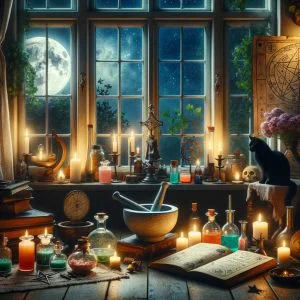
3. Understanding Witchcraft
Welcome to the mystical realm of witchcraft for beginners, a path brimming with wonder and discovery. This section will unveil the essence of what it means to walk the witch's path.
3.1 Beliefs And Practices
The core of witchcraft lies in its diverse beliefs and rituals. Practitioners embrace the natural world and its cycles. Here are key points:
- Connection to nature: Many witches honor the Earth and its seasons.
- Deity worship: Some follow multiple gods and goddesses, while others prefer a single spirit.
- Rituals: These are crafted to align with celestial events like solstices.
- Tools: Witches often use items like crystals, herbs, and wands in their practice.
- Community: Many find strength and growth within covens or solo practices.
3.2 Wicca Vs. Traditional Witchcraft
While similar, Wicca and Traditional Witchcraft hold distinct differences.
| Aspect | Wicca | Traditional Witchcraft |
|---|---|---|
| Origin | 1950s England | Ancient practices |
| Deities | Dual god and goddess | Varied, ancestral spirits |
| Ritual Structure | Formal | Flexible |
| Beliefs | Rede and Threefold Law | Personal responsibility |
| Practice | Covens or solo | Often solitary |
3.3 Magic And Spellcasting
Magic is the pulsing heart of witchcraft. Spellcasting is a skill witches use to create change.
Consider these elements of magical work:
- Intention: Clear focus directs energy.
- Visualization: Picturing the desired outcome boosts the spell's effectiveness.
- Ingredients: Each has its own power, contributing to the spell's purpose.
- Timing: Spells often tie to lunar phases or specific days for potent results.
Remember, ethical practitioners abide by a key rule: harm none.
4. Essential Tools
Starting out witchcraft for beginners is exciting. But it's crucial to know the essential tools you will need. With the right tools, you can perform spells, rituals, and other magical works more effectively.
4.1 Altar Setup
Creating a sacred space is vital for your witchcraft practice. An altar acts as a focal point for your energy.
- A table or shelf serves as the base.
- Choose representations of the four elements: earth, air, fire, and water.
- Candles bring light and focus.
- Add personal items that possess special meaning.
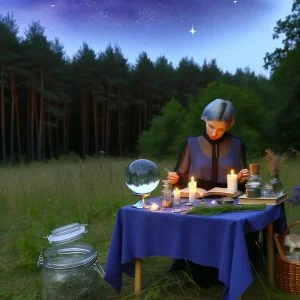
4.2 Ritual Tools
These tools assist in directing your intention during rituals.
- A wand directs energy.
- A pentacle protects and grounds.
- A chalice holds ritual beverages.
- Incense helps to cleanse the space.
- Athame (or ritual knife) defines boundaries and directs energy.
4.3 Herbology And Crystals
Herbs and crystals are powerful allies in magic. They hold unique energies and properties.
| Herb | Property | Crystal | Energy |
|---|---|---|---|
| Lavender | Calming | Amethyst | Intuition |
| Rosemary | Protection | Clear Quartz | Healing |
| Mugwort | Lucid dreaming | Tiger's Eye | Courage |
5. Spellcasting Basics
Starting your journey into witchcraft can be both exhilarating and overwhelming. Spellcasting is a cornerstone of witchcraft that allows you to harness energy and manifest your intentions. Dive into the essentials with these fundamental steps to casting spells.
5.1 Creating Intention
Every spell starts with a purpose. Setting a clear intention is crucial. It directs your energy and focus. Picture your goal vividly in your mind. Feel the emotions connected to your desired outcome. Write your intention on paper, making it tangible and potent.
5.2 Types Of Spells
- Love Spells: Attract love or deepen existing relationships.
- Protection Spells: Shield against negative energies.
- Healing Spells: Promote physical or emotional healing.
- Prosperity Spells: Draw abundance and financial growth.
Different spells cater to various needs. Choose one that aligns with your intentions.
5.3 Performing Rituals
Rituals are a set of actions that prep you and your space for spellcasting. Begin by cleansing your space with sage or incense. Gather your tools—candles, crystals, or herbs. Cast a circle to create a protective bubble around you. Focus your energy before you chant or visualize your spell, then close the circle, thanking any spirits or deities involved.
Remember: practice makes perfect. Keep your rituals simple at first. Grow your skills from there.
6. Protection And Energy Cleansing
Stepping into the world of witchcraft calls for a shield from unwanted energies. Beginners soon discover the importance of protection and energy cleansing. These practices help keep you safe. They clear your space from negative vibes. Let's explore the essential techniques for a peaceful witchcraft journey.

6.1 Warding
Warding acts like an invisible fence. It keeps out harmful energies. You can set wards around your home or wear talismans for personal protection. Simple warding methods include:
- Chanting Protective Spells – Use words of power to cast a protective barrier.
- Using Salt – Sprinkle salt at doorways or windows as a classic ward.
- Placing Crystals – Set crystals like black tourmaline near entry points.
6.2 Shielding
Imagine wrapping yourself in a shield of energy. This is what shielding is about. It's your personal guard against negativity. Key points for shielding include:
- Meditation – Visualize a bubble of light around you for protection.
- Breathwork – Use focused breathing to strengthen your energy shield.
- Affirmations – Positive affirmations can empower your shields.
6.3 Cleansing Techniques
Like dusting your home, cleansing is about tidying your energy space. It removes bad vibes. It refreshes your spirit. Try these simple methods:
- Smudging – Burn sage or palo santo to cleanse your area.
- Sound – Use bells or chimes to break up stagnant energy.
- Salt Baths – Soak in saltwater to purify your aura.
- Nature Walks – Allow the natural world to restore your balance.
These techniques serve as the starting toolkit for any budding practitioner. Regular practice keeps energy fresh and defenses strong!
7. Connecting With Nature
Nature serves as a vast wellspring of energy and inspiration for those stepping into the realm of witchcraft. It provides tools, symbols, and direct influences on magical work. For beginners, understanding and harnessing these natural connections is a key step in developing one's craft. Let's explore how to engage with the elements, lunar cycles, and creating your own sacred spaces.
7.1 Elemental Magick
Elemental Magick involves calling upon the forces of the four elements: Earth, Air, Fire, and Water. Each element corresponds to different aspects of nature and life. Here are simple ways to incorporate them:
- Earth: Plant herbs or work with green stones like emerald.
- Air: Use feathers or wind chimes to capture its essence.
- Fire: Light candles to invite warmth and transformation.
- Water: Use sea shells or bowl of water for cleansing rituals.

7.2 Moon Phases And Rituals
The moon influences emotions and spiritual growth. Track its phases and align your actions for greater impact. See below for moon phase meanings:
| Moon Phase | Meaning |
|---|---|
| New Moon | Set intentions and start new projects. |
| Waxing Moon | Build and develop your plans. |
| Full Moon | Release and let go of what no longer serves you. |
| Waning Moon | Reflect and rest, prepare for a new cycle. |
Create moon-related rituals to tap into this energy. Use clear crystals to reflect moonlight during meditations, for instance.
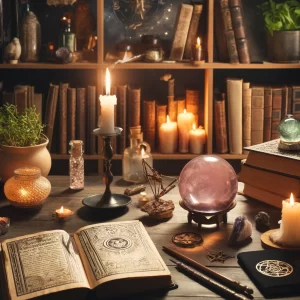
7.3 Sacred Spaces
Establishing a sacred space is essential. This space is your sanctuary, a place to connect and ground with nature's energy. Here are ideas to start:
- Select a quiet spot in nature or your garden.
- Use stones or crystals to mark the area's boundaries.
- Include items that represent the elements to you.
- Keep it clean and treat it with respect.
Personalize your sacred space with items that carry meaning. These could be feathers, special rocks, or plants.
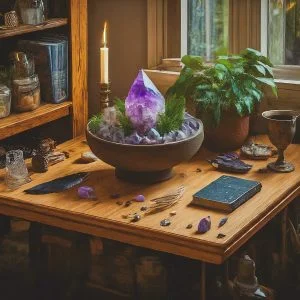
8. Next Steps
Embarking on your witchcraft journey marks the beginning of a transformative path. Your foundation is set. Ready to deepen your practice? Explore here.
8.1 Finding A Coven Or Community
Connect with like-minded individuals to enhance your craft. Meet peers and mentors for guidance and support.
- Search online for local covens or virtual communities.
- Attend witchcraft fairs and gatherings.
- Join social media groups focused on witchcraft.
8.2 Continuing Education
Knowledge is your most powerful tool. Keep learning to grow your abilities. Below are steps to advance your witchcraft education.
- Read books by reputable authors.
- Enroll in online courses or workshops.
- Subscribe to witchcraft podcasts and channels.
8.3 Personal Growth And Practice
Personal practice is key in witchcraft. Discover your unique path through regular rituals and reflection.
| Daily Practices | Self-Reflection | Experimentation |
|---|---|---|
| Meditation | Journalling | Trying new spells |
| Grounding exercises | Tracking moon phases | Mixing herbs |
Track your growth and celebrate your milestones. Always practice safely and respect nature.
- 19 Herbs for Both Pagan and Witchcraft RitualsAs an Amazon Associate I earn from qualifying purchases.Introduction to 19 Herbs for Both Pagan and Witchcraft Rituals In the realm of Paganism and witchcraft, the use of herbs transcends mere ritualistic purposes; it is a practice deeply rooted in history and tradition. Over the centuries, practitioners have harnessed the power of various herbs for… Read more: 19 Herbs for Both Pagan and Witchcraft Rituals
- 16 Common Spells for Manifesting Your DesiresAs an Amazon Associate I earn from qualifying purchases. u003cH2u003e16 Common Spells for Manifesting Your Desiresu003c/H2u003e u003cH3u003eAttention-Grabbing Introductionu003c/H3u003e Magic and spells have captivated human imagination for centuries, with over 76% of people believing in some form of magic or supernatural power. The practice of casting spells to manifest desires is an ancient art that has… Read more: 16 Common Spells for Manifesting Your Desires
- 12 Books on Witchcraft for Norse PagansAs an Amazon Associate I earn from qualifying purchases.An Introduction to Witchcraft and Norse Paganism Witchcraft and Norse paganism are ancient practices that date back to the pre-Christian era and have been preserved through oral traditions and ancient texts. The intertwining of these traditions offers a rich tapestry of myth, ritual, and magic. In recent… Read more: 12 Books on Witchcraft for Norse Pagans
- 21 Rituals to Honor the Ancestors in Norse PaganismAs an Amazon Associate I earn from qualifying purchases.21 Rituals to Honor the Ancestors in Norse Paganism Introduction to Ancestral Rituals Norse Paganism, an ancient spiritual tradition, emphasizes the veneration of ancestors through a variety of rituals, many of which have survived or been revived in contemporary times. These rituals serve not only as a… Read more: 21 Rituals to Honor the Ancestors in Norse Paganism
- 21 Healing Spells for Both Pagans and WitchesAs an Amazon Associate I earn from qualifying purchases.21 Healing Spells: Bridging Ancient Practice with Modern Needs Did you know that the practice of healing spells dates back thousands of years and can be found in nearly every culture worldwide? These spells have evolved significantly over centuries, adapting to the needs and beliefs of differing… Read more: 21 Healing Spells for Both Pagans and Witches
- 23 Differences Between Norse Paganism and AsatruAs an Amazon Associate I earn from qualifying purchases. An Insight into Norse Paganism and Asatru Historical Background Norse Paganism and Asatru are often used interchangeably, but they hold distinct differences. Norse Paganism is a broad term referring to the various religious practices of the Norse people before the Christianization of Scandinavia. Asatru, on the… Read more: 23 Differences Between Norse Paganism and Asatru
- 18 Myths and Legends Every Norse Pagan Should KnowAs an Amazon Associate I earn from qualifying purchases. 18 Myths and Legends Every Norse Pagan Should Know Intriguing Norse Myths and Legends Renowned for their seafaring exploits and rich oral traditions, the Norse people have passed down captivating myths and legends that have profoundly influenced modern literature and culture. At the heart of these… Read more: 18 Myths and Legends Every Norse Pagan Should Know
- 13 Common Misconceptions About Paganism DebunkedAs an Amazon Associate I earn from qualifying purchases. Paganism is an umbrella term that encompasses a variety of religious traditions that are primarily nature-based and polytheistic. Despite its rich historical roots and increasing modern-day relevance, many misconceptions persist about Pagan belief systems. Introduction to 13 Common Misconceptions About Paganism Debunked Paganism has seen a… Read more: 13 Common Misconceptions About Paganism Debunked
- 23 Powerful Spells for Personal EmpowermentAs an Amazon Associate I earn from qualifying purchases.The Power of Spells: An Intriguing Insight Spells have been a part of human culture for millennia, often perceived as mystical rituals capable of altering reality. In modern times, 23 Powerful Spells for Personal Empowerment have gained popularity for their potential to harness inner strength and achieve… Read more: 23 Powerful Spells for Personal Empowerment
- 16 Tools Every Witch Should Have on Their AltarAs an Amazon Associate I earn from qualifying purchases.An Essential Collection for Modern Witches Magic and ritual practice have been around for centuries, often tied to cultural and spiritual traditions. In modern witchcraft, having the right tools on an altar is essential for focusing energy and intentions. Today, witches use a standardized collection of 16… Read more: 16 Tools Every Witch Should Have on Their Altar
- 19 Simple Protection Spells for BeginnersAs an Amazon Associate I earn from qualifying purchases.Understanding Protection Spells Protection spells are magical practices designed to guard individuals against harm, negativity, and unwanted energies. These spells can encompass rituals, chants, and symbolic actions that invoke safety and security. Rooted in ancient traditions, they have evolved over time but continue to play a significant… Read more: 19 Simple Protection Spells for Beginners
- 16 Rituals to Align with Your Magickal SelfAs an Amazon Associate I earn from qualifying purchases.Introduction to Magickal Rituals Magickal rituals are time-honored practices designed to align one’s spiritual energy and intention with the cosmic forces. Rooted in ancient traditions, these rituals have evolved over centuries to become an essential part of various spiritual practices. The 16 Rituals to Align with Your… Read more: 16 Rituals to Align with Your Magickal Self
- 12 Advanced Magick Practices for Experienced WitchesAs an Amazon Associate I earn from qualifying purchases.“`html 12 Advanced Magick Practices for Experienced Witches An Overview of Ritual Sigil Crafting Ritual Sigil Crafting rises from ancient traditions where symbols were believed to hold potent power capable of altering reality. In modern practices, experienced witches harness this method to manifest desires and protect against… Read more: 12 Advanced Magick Practices for Experienced Witches
- 16 Key Differences Between Celtic and Roman PaganismAs an Amazon Associate I earn from qualifying purchases. 03cH203eAn Introduction to the 16 Key Differences Between Celtic and Roman Paganism03c/H203e Roman Paganism involved a pantheon where even the heads of state such as Julius Caesar were deified, while Celtic Paganism focused on a more nature-oriented spirituality. Between the intricate rituals of Roman Paganism and… Read more: 16 Key Differences Between Celtic and Roman Paganism
- 17 Sacred Herbs for Witchcraft and Pagan MagickAs an Amazon Associate I earn from qualifying purchases. Introduction Herbs have been used in spiritual practices for thousands of years, often considered sacred in various traditions due to their assigned magical properties. In the realm of witchcraft and Pagan magick, 17 specific sacred herbs are revered for their potent powers. Historically, these herbs have… Read more: 17 Sacred Herbs for Witchcraft and Pagan Magick
- 20 Candle Spells to Bring Peace and ProtectionAs an Amazon Associate I earn from qualifying purchases. 03cH203e20 Candle Spells to Bring Peace and Protection03c/H203e 03cH303eIntroduction to Candle Spells03c/H303e Candle spells have been utilized for centuries as a form of ritualistic magic, offering individuals a tangible connection to their intentions through the power of light and fire. Originating from ancient practices, these spells… Read more: 20 Candle Spells to Bring Peace and Protection
- 21 Differences Between Traditional Wicca and Eclectic WiccaAs an Amazon Associate I earn from qualifying purchases. Introduction to Wicca Traditional Wicca and Eclectic Wicca represent two distinct paths within the modern Pagan religious movement. According to a 2014 Pew Research Center study, approximately 0.4% of American adults identify as Wiccan or Pagan. Both subcategories of Wicca have gained significant followings, each offering… Read more: 21 Differences Between Traditional Wicca and Eclectic Wicca
- 22 Ritual Tools Every Norse Pagan Witch Should UseAs an Amazon Associate I earn from qualifying purchases. Essential Ritual Tools for Norse Pagan Witches Mjölnir The Mjölnir, or Thor's Hammer, is a powerful symbol in Norse mythology, often used for protection and consecration in rituals. Historically, the hammer symbolizes the might of Thor, the Norse god of thunder, providing a sense of strength… Read more: 22 Ritual Tools Every Norse Pagan Witch Should Use
- 21 Sacred Herbs in Pagan and Witchcraft TraditionsAs an Amazon Associate I earn from qualifying purchases.Below is a structured and informative set of paragraphs about 21 Sacred Herbs in Pagan and Witchcraft Traditions following the given rules. Introduction to 21 Sacred Herbs in Pagan and Witchcraft Traditions Did you know that the use of sacred herbs in pagan rituals dates back thousands… Read more: 21 Sacred Herbs in Pagan and Witchcraft Traditions
- 25 Symbols and Their Meanings in Pagan TraditionsAs an Amazon Associate I earn from qualifying purchases. “`html Introduction to Pagan Symbols Pagan symbols have been around for thousands of years, their meanings deeply rooted in nature, spirituality, and the human experience. One of the most fascinating aspects of Pagan traditions is the rich tapestry of symbols and their meanings. These symbols often… Read more: 25 Symbols and Their Meanings in Pagan Traditions
- 20 Healing Spells Using Crystals and HerbsAs an Amazon Associate I earn from qualifying purchases. H2Healing Spells Using Crystals and Herbs: A Timeless PracticeH2 H3Introduction to Healing Spells with Crystals and HerbsH3 Magic and healing rituals have been an integral part of human culture for millennia, with archaeological evidence of crystal healing dating back to prehistoric times. The ancient Egyptians, Greeks,… Read more: 20 Healing Spells Using Crystals and Herbs
- 18 Ways to Use the Elements in WitchcraftAs an Amazon Associate I earn from qualifying purchases.“`html Introduction to the Elements in Witchcraft In witchcraft, the four classical elements – Earth, Air, Fire, and Water – are fundamental to a variety of practices and rituals. These elements have been revered since ancient civilizations, evidenced by their prominent roles in philosophies and spiritual practices… Read more: 18 Ways to Use the Elements in Witchcraft
- 18 Core Values of Norse PaganismAs an Amazon Associate I earn from qualifying purchases. What Are the 18 Core Values of Norse Paganism? The 18 Core Values of Norse Paganism are guiding principles derived from the ancient Norse belief system that continue to hold significant influence today. These values are deeply rooted in the traditions and literature of the Norse… Read more: 18 Core Values of Norse Paganism
- 20 Ways to Honor Your Ancestry in Witchcraft and PaganismAs an Amazon Associate I earn from qualifying purchases. Historically, witchcraft and paganism have often centered around ancestral reverence and the practice of connecting with lineage spirits. This connection remains a powerful aspect of many spiritual practices today, with over a million people in the United States alone identifying with some form of Pagan belief… Read more: 20 Ways to Honor Your Ancestry in Witchcraft and Paganism
- 23 Key Differences Between Ritual Magick and Chaos MagickAs an Amazon Associate I earn from qualifying purchases. u003cH2u003eAttention-Grabbing Factu003c/H2u003e Ritual Magick and Chaos Magick, though both falling under the broad umbrella of occult practices, hold fundamentally different philosophies and methodologies. Ritual Magick is steeped in tradition, with meticulously structured rituals aimed at specific outcomes. In contrast, Chaos Magick embraces flexibility and the pragmatic… Read more: 23 Key Differences Between Ritual Magick and Chaos Magick
- 21 Sacred Trees in Norse Paganism and Their Magickal UsesAs an Amazon Associate I earn from qualifying purchases. “`html 21 Sacred Trees in Norse Paganism and Their Magickal Uses Awe-Inspiring Fact In Norse Paganism, trees are much more than just natural wonders; they are sacred entities, revered for their mystical properties and magickal uses. Introduction Rooted deeply in the belief system of Norse Paganism,… Read more: 21 Sacred Trees in Norse Paganism and Their Magickal Uses
- 22 Prosperity Spells for Abundance and GrowthAs an Amazon Associate I earn from qualifying purchases.“`html Discovering Prosperity Spells: A Path to Abundance and Growth The concept of prosperity spells has been around for centuries, and people have used them to attract wealth and success. These spells come in various forms, each designed to trigger financial growth and personal abundance. Throughout history,… Read more: 22 Prosperity Spells for Abundance and Growth
- 13 Differences Between Traditional Witchcraft and Modern WiccaAs an Amazon Associate I earn from qualifying purchases.“`html Attention-Grabbing Fact Traditional Witchcraft and Modern Wicca, while often conflated, are distinct practices with unique histories and philosophies, each attracting a diverse following in today's spiritual landscape. Introduction and History Traditional Witchcraft traces its roots back to pre-Christian pagan practices, focusing heavily on folk magic and… Read more: 13 Differences Between Traditional Witchcraft and Modern Wicca
- 13 Key Deities Worshipped in Both Witchcraft and PaganismAs an Amazon Associate I earn from qualifying purchases.Introduction to Key Deities Worshipped in Both Witchcraft and Paganism Paganism and witchcraft, though distinct in practices and history, share a profound reverence for certain deities whose stories span across millennia. Ancient civilizations bestowed upon us a pantheon of gods and goddesses, each embodying critical natural forces… Read more: 13 Key Deities Worshipped in Both Witchcraft and Paganism
- 17 Gods and Goddesses in Norse Paganism You Should HonorAs an Amazon Associate I earn from qualifying purchases. [] Introduction to Norse Paganism Deities Norse Paganism, or Asatru, is experiencing a modern revival with significant growth in followers around the world. This ancient belief system, rooted in the traditions and mythology of the Norse people of Scandinavia, intricately weaves the fates of gods and… Read more: 17 Gods and Goddesses in Norse Paganism You Should Honor
- 14 Books Every Wiccan Should Have on Their ShelfAs an Amazon Associate I earn from qualifying purchases. u003cH2u003eUnderstanding the Essentials of Wiccan Literatureu003c/H2u003e Wicca is a modern pagan religion with spiritual roots in the earliest expressions of reverence for nature. One of the fascinating aspects of Wicca is its rich literary tradition, which serves as both guidance and inspiration for practitioners. These books… Read more: 14 Books Every Wiccan Should Have on Their Shelf
- 19 Powerful Rituals for Connecting with OdinAs an Amazon Associate I earn from qualifying purchases. 19 Powerful Rituals for Connecting with Odin Introduction and Historical Context The Norse god Odin, often associated with wisdom, war, and death, has been a figure of veneration for centuries. As the Allfather in Norse mythology, Odin's influence spreads across literature, history, and modern spiritual practices.… Read more: 19 Powerful Rituals for Connecting with Odin
- 25 Love Spells for Practicing WitchesAs an Amazon Associate I earn from qualifying purchases.Exploration of 25 Love Spells for Practicing Witches Introduction to Love Spells Love spells have fascinated humanity for centuries, with historical records dating back to ancient civilizations like the Egyptians and Greeks. These spells are a form of magic intended to attract, enhance, or heal romantic connections.… Read more: 25 Love Spells for Practicing Witches
- 15 Crystals for Every Witch’s ToolkitAs an Amazon Associate I earn from qualifying purchases. “`html Introduction to 15 Crystals for Every Witch’s Toolkit Did you know that crystals have been used for magical and healing purposes for thousands of years? In today's world, many practitioners of witchcraft consider them to be essential tools in their spiritual toolkit. Crystals are lauded… Read more: 15 Crystals for Every Witch’s Toolkit
- 14 Rituals to Honor the Norse God OdinAs an Amazon Associate I earn from qualifying purchases. 14 Rituals to Honor the Norse God Odin Understanding the 14 Rituals to Honor the Norse God Odin Historical Roots of Odin Worship Odin, often regarded as the Allfather in Norse mythology, is a central figure in the pantheon of gods. Historically, the Viking Age saw… Read more: 14 Rituals to Honor the Norse God Odin
- 24 Key Figures in the History of Celtic PaganismAs an Amazon Associate I earn from qualifying purchases.“`html 24 Key Figures in the History of Celtic Paganism Introduction Celtic Paganism, an ancient spiritual tradition steeped in lush folklore and powerful mythos, has seen a resurgence in interest in recent years. Despite centuries of suppression, practitioners today honor the heritage of the Celts, seeking wisdom… Read more: 24 Key Figures in the History of Celtic Paganism
- 14 Notable Witches Throughout HistoryAs an Amazon Associate I earn from qualifying purchases.u003cH2u003eIntroducing 14 Notable Witches Throughout Historyu003c/H2u003e In the realm of folklore and history, witches have always had a place, often affiliated with both fear and fascination. With approximately 1 million people accused of witchcraft across Europe between the 15th and 18th centuries, the impact of these figures… Read more: 14 Notable Witches Throughout History
- 20 Popular Norse Pagan Spells You Should TryAs an Amazon Associate I earn from qualifying purchases.u003cH2u003e20 Popular Norse Pagan Spells You Should Tryu003c/H2u003e Norse paganism, also known as Heathenry, centers around the veneration of the gods, natural spirits, and ancestors. This ancient belief system incorporates a rich tapestry of myths, legends, and, notably, spells believed to harness the powers of the divine.… Read more: 20 Popular Norse Pagan Spells You Should Try
- 23 Simple Spells for Pagan and Wiccan PractitionersAs an Amazon Associate I earn from qualifying purchases.Introduction to 23 Simple Spells for Pagan and Wiccan Practitioners One fascinating aspect of Pagan and Wiccan practices is the use of simple spells to connect with nature, harness natural energies, and manifest intentions. The practice of spellcasting has been part of human culture for centuries, offering… Read more: 23 Simple Spells for Pagan and Wiccan Practitioners
- 20 Sacred Pagan Temples and Sites to VisitAs an Amazon Associate I earn from qualifying purchases. u003cH2u003eIntroduction to Sacred Pagan Temples and Sitesu003c/H2u003e Paganism, a collection of diverse religious traditions rooted in nature worship and polytheism, predates many of the world’s major religions by thousands of years. Across the globe, numerous pagan temples and sacred sites serve as enduring testaments to these… Read more: 20 Sacred Pagan Temples and Sites to Visit
- 20 Sacred Witchcraft Rituals for the Full MoonAs an Amazon Associate I earn from qualifying purchases.Introduction to 20 Sacred Witchcraft Rituals for the Full Moon The full moon has long been associated with magic and witchcraft, inspiring countless legends and spiritual practices. Ancient cultures recognized the full moon’s potent energy and created rituals to harness its power. Today, 20 sacred witchcraft rituals… Read more: 20 Sacred Witchcraft Rituals for the Full Moon
- 13 Famous Books on Witchcraft You Should ReadAs an Amazon Associate I earn from qualifying purchases. “`html Understanding Witchcraft Through Literature The Malleus Maleficarum Published in the late 15th century, “The Malleus Maleficarum” by Heinrich Kramer and Jacob Sprenger is often referred to as the definitive work on witchcraft. It laid the groundwork for many subsequent witch trials and was widely consulted… Read more: 13 Famous Books on Witchcraft You Should Read
- 15 Key Differences Between Celtic and Norse PaganismAs an Amazon Associate I earn from qualifying purchases.u003cH2u003e15 Key Differences Between Celtic and Norse Paganismu003c/H2u003e u003cH3u003eHistorical Backgroundu003c/H3u003e Paganism refers to the spiritual and religious beliefs practiced by various tribes and cultures before the spread of organized religions like Christianity. Two prominent forms of paganism that have been studied extensively are Celtic and Norse paganism.… Read more: 15 Key Differences Between Celtic and Norse Paganism
- 14 Popular Pagan Spells for Everyday UseAs an Amazon Associate I earn from qualifying purchases. Understanding Pagan Spells Paganism, a term that encompasses a wide variety of spiritual and religious practices, is often associated with the harnessing of natural energies and ancient rituals. One intriguing aspect of paganism is the use of spells, which are employed for various purposes ranging from… Read more: 14 Popular Pagan Spells for Everyday Use
- 22 Sacred Sites Important to Both Witches and PagansAs an Amazon Associate I earn from qualifying purchases.A Realm of Mystique: 22 Sacred Sites Revered by Witches and Pagans Unveiling the Sacredness For centuries, certain places across the globe have been veiled in mystique and revered by those practicing witchcraft and pagan traditions. These sites, imbued with spiritual energy, are believed to hold profound… Read more: 22 Sacred Sites Important to Both Witches and Pagans
- 18 Crystals Every Magick Practitioner Should UseAs an Amazon Associate I earn from qualifying purchases. Introduction to Essential Crystals in Magick The use of crystals in magick dates back thousands of years, with ancient civilizations like the Egyptians and Sumerians utilizing them for their believed mystical properties. As magick practices have evolved, the inclusion of specific crystals has become a staple… Read more: 18 Crystals Every Magick Practitioner Should Use
- 23 Differences Between Celtic and Norse Pagan RitualsAs an Amazon Associate I earn from qualifying purchases.“`html An Exploration into the Distinct Characteristics of Celtic and Norse Pagan Rituals Celtic and Norse pagan rituals are rich in history, yet exhibit remarkably different traditions that have captivated scholars and enthusiasts alike. Paganism, rooted in the pre-Christian traditions of Europe, reveals unique cultural tapestries that… Read more: 23 Differences Between Celtic and Norse Pagan Rituals
- 19 Types of Wiccan Covens and How to Join OneAs an Amazon Associate I earn from qualifying purchases.“`html Introduction Wicca, a modern Pagan religion, often gathers practitioners in various groups known as covens. These covens range widely in focus, practice, and tradition, reflecting the diverse nature of Wicca itself. The concept of Wiccan covens has evolved significantly since the mid-20th century when Gerald Gardner,… Read more: 19 Types of Wiccan Covens and How to Join One
- 23 Tools Every Practitioner of Magick Should OwnAs an Amazon Associate I earn from qualifying purchases. The Essential Use of Tools in Practicing Magick Historical Background and Current Significance Magick, a practice that has been around for thousands of years, often relies on various tools to focus the practitioner's intent and channel energy more effectively. Traditionally, these tools have ranged from the… Read more: 23 Tools Every Practitioner of Magick Should Own
- 25 Sacred Trees in Pagan and Norse TraditionsAs an Amazon Associate I earn from qualifying purchases. Pagan and Norse Traditions: 25 Sacred Trees The Reverence for Trees in Ancient Cultures Ancient Pagans and Norse people revered trees as sacred entities, intertwining their existence with spiritual beliefs and daily lives. In these traditions, trees were not only symbols of life and growth but… Read more: 25 Sacred Trees in Pagan and Norse Traditions
- 20 Magickal Spells for Self-EmpowermentAs an Amazon Associate I earn from qualifying purchases. u003cH2u003eUnderstanding 20 Magickal Spells for Self-Empowermentu003c/H2u003e u003cpu003eMagickal spells for self-empowerment have roots in ancient traditions and have evolved through various cultures and eras. Today, these practices are embraced globally by individuals seeking personal growth, healing, and a deeper connection with their innate power. With the growing… Read more: 20 Magickal Spells for Self-Empowerment
- 22 Runes and Their Uses in Magick and PaganismAs an Amazon Associate I earn from qualifying purchases.22 Runes and Their Uses in Magick and Paganism Introduction to Runes Runes are an ancient alphabetic script used in Germanic languages before the adoption of the Latin alphabet. These symbols possess both phonetic and mystical qualities, enabling them to serve as a rich repository of magickal… Read more: 22 Runes and Their Uses in Magick and Paganism
- 19 Tools You Need to Practice Magick EffectivelyAs an Amazon Associate I earn from qualifying purchases. An Ancient Practice in the Modern World Practicing magick has been a part of human culture for centuries, with roots tracing back to ancient civilizations like Egypt and Babylon. Today, this mystical practice has evolved but remains relevant, offering a blend of tradition and modernity. According… Read more: 19 Tools You Need to Practice Magick Effectively
- 14 Books to Learn the Foundations of Norse PaganismAs an Amazon Associate I earn from qualifying purchases. Introduction to Norse Paganism Norse Paganism, also known as Ásatrú, is a modern revival of ancient Norse religious traditions that honor gods such as Odin, Thor, and Freyja. Rooted in medieval Icelandic texts and archaeological findings, this spiritual path has seen a resurgence in recent years.… Read more: 14 Books to Learn the Foundations of Norse Paganism
- 25 Sacred Symbols in Paganism and Their OriginsAs an Amazon Associate I earn from qualifying purchases. 25 Sacred Symbols in Paganism and Their Origins Introduction to Pagan Symbols Paganism, an ancient and diverse spiritual practice, is rich with symbolism that dates back to early human civilizations. Pagan symbols carry potent meanings and are often used in rituals, amulets, and decorations. Many of… Read more: 25 Sacred Symbols in Paganism and Their Origins
- 15 Core Practices Every Witch Should KnowAs an Amazon Associate I earn from qualifying purchases. Introduction to Core Practices Did you know that witchcraft, often perceived as an ancient practice, has seen a remarkable resurgence in modern times, especially among millennials and Gen Z? Today's witches blend age-old traditions with contemporary practices to foster personal growth, spiritual connection, and empowerment. This… Read more: 15 Core Practices Every Witch Should Know
- 24 Essential Magickal Herbs and Their UsesAs an Amazon Associate I earn from qualifying purchases. 24 Essential Magickal Herbs and Their Uses The Power of Magickal Herbs From ancient civilizations to modern-day practitioners, magickal herbs have always been revered for their potent abilities to heal, protect, and enhance spiritual work. The use of these herbs can be traced back to ancient… Read more: 24 Essential Magickal Herbs and Their Uses
- 16 Powerful Spells for Working With the Norse GodsAs an Amazon Associate I earn from qualifying purchases.Introduction to Norse Spellwork and Its Significance Background and Importance The ancient Norse people believed that their gods wielded incredible powers through specialized spells, enabling them to influence the world around them. In modern times, these powerful spells are experiencing resurgence among those interested in Norse mythology… Read more: 16 Powerful Spells for Working With the Norse Gods
- 15 Differences Between Witchcraft, Wicca, and PaganismAs an Amazon Associate I earn from qualifying purchases.Understanding Witchcraft, Wicca, and Paganism Historical Background and Current Significance Witchcraft, Wicca, and Paganism are often considered part of a broader category of spiritual and religious practices. Witchcraft historically refers to the practice of magical skills, spells, and abilities. Wicca, introduced in the mid-20th century by Gerald… Read more: 15 Differences Between Witchcraft, Wicca, and Paganism
- 18 Common Rites of Passage in Norse Pagan TraditionsAs an Amazon Associate I earn from qualifying purchases. Introduction The Importance of Rites of Passage Norse Pagan traditions place significant importance on rites of passage, which are ceremonial events that mark crucial stages in a person's life. Rooted in ancient customs, these ceremonies symbolically honor the transitions from one phase to another, such as… Read more: 18 Common Rites of Passage in Norse Pagan Traditions
- 14 Ways to Incorporate Pagan Rites into WitchcraftAs an Amazon Associate I earn from qualifying purchases. u003cH2u003eIntroductionu003c/H2u003e u003cpu003eWitchcraft and Paganism have deep historical roots, intertwined and evolving through centuries. Modern-day witchcraft enthusiasts are increasingly looking for ways to incorporate ancient Pagan rites into their practices to harness their energy and spiritual significance. This melding of traditions not only enriches the craft but… Read more: 14 Ways to Incorporate Pagan Rites into Witchcraft
- 22 Wiccan Beliefs That Will Deepen Your Spiritual PracticeAs an Amazon Associate I earn from qualifying purchases. Introduction to Wiccan Beliefs Wicca, a modern Pagan religious movement, profoundly emphasizes respect for nature and the interconnectedness of all life. Wiccan beliefs, established in the early 20th century, have continuously evolved, appealing to many seeking spirituality aligned with nature. Gerald Gardner, considered the father of… Read more: 22 Wiccan Beliefs That Will Deepen Your Spiritual Practice
- 14 Key Differences Between Pagan Rituals and WitchcraftAs an Amazon Associate I earn from qualifying purchases. Introduction to Pagan Rituals and Witchcraft Pagan rituals and witchcraft are often conflated, yet they possess distinct characteristics that set them apart. Paganism refers to a group of contemporary religions that draw inspiration from the ancient traditions of the pre-Christian world. Witchcraft, on the other hand,… Read more: 14 Key Differences Between Pagan Rituals and Witchcraft
- 19 Rituals to Celebrate Norse Pagan HolidaysAs an Amazon Associate I earn from qualifying purchases. u003cH2u003e19 Rituals to Celebrate Norse Pagan Holidaysu003c/H2u003e u003cH3u003eIntroduction to Norse Pagan Celebrationsu003c/H3u003e Norse Paganism, also known as Heathenry, holds timeless rituals and customs that intricately align with the cycles of nature. With roots tracing back to pre-Christian Scandinavia, Norse paganism continues to capture interest today for… Read more: 19 Rituals to Celebrate Norse Pagan Holidays
- 13 Differences Between Paganism and WiccaAs an Amazon Associate I earn from qualifying purchases.u003cH2u003eA Historical Overview of Paganism and Wiccau003c/H2u003e u003cH3u003eDefinition and Originsu003c/H3u003e Established centuries ago, Paganism is a term that encompasses a variety of polytheistic, nature-based religious traditions. Wicca, however, is a relatively modern spiritual path founded in the 20th century by Gerald Gardner. Despite both being under the… Read more: 13 Differences Between Paganism and Wicca
- 17 Ways to Incorporate Witchcraft into Pagan RitualsAs an Amazon Associate I earn from qualifying purchases.u003cH2u003eIntroduction to Witchcraft and Pagan Ritualsu003c/H2u003e Witchcraft has been intertwined with pagan rituals for centuries, acting as a bridge between the earthly and the mystical. This practice, which spans across diverse cultures and traditions, involves invoking natural energies and using magical elements to achieve harmony and spiritual… Read more: 17 Ways to Incorporate Witchcraft into Pagan Rituals
- 23 Powerful Protection Spells for Norse PagansAs an Amazon Associate I earn from qualifying purchases.u003cH2u003eA Rich Tradition in Norse Paganismu003c/H2u003e Norse Paganism, or Heathenry, is a spiritual path rooted in the ancient religious practices of the Norse people. This tradition includes a wide array of rituals, mythology, and lore, one of which is the use of powerful protection spells. These spells… Read more: 23 Powerful Protection Spells for Norse Pagans
- 14 Books to Learn About Ancient Pagan RitualsAs an Amazon Associate I earn from qualifying purchases. 14 Books to Learn About Ancient Pagan Rituals An Insight Into Ancient Pagan Rituals Through Literature Did you know that ancient pagan rituals form the basis of many modern practices and celebrations? Rooted in pre-Christian spiritual traditions, these rituals offer a window into human history and… Read more: 14 Books to Learn About Ancient Pagan Rituals
- 24 Simple Spells for New WitchesAs an Amazon Associate I earn from qualifying purchases. The Magical World of Simple Spells Introduction to Simple Spells The practice of witchcraft and spell casting carries a long history that stretches back to ancient civilizations, where individuals sought to connect with natural and supernatural forces for guidance and aid. In the context of modern… Read more: 24 Simple Spells for New Witches
- 22 Popular Magick Spells You Should Try TodayAs an Amazon Associate I earn from qualifying purchases.Introduction to Popular Magick Spells Magick spells have evolved from ancient rituals performed by shamans and priests to modern-day practices that you can try at home. The concept of magick spells spans thousands of years, with origins in ancient Egypt, Greece, and Rome. Today, magick spells continue… Read more: 22 Popular Magick Spells You Should Try Today
- 14 Important Texts in Norse Pagan LoreAs an Amazon Associate I earn from qualifying purchases. The Poetic Edda Historical Background The Poetic Edda, also known as the Elder Edda, is a collection of Old Norse poems primarily preserved in the 13th-century manuscript Codex Regius. It is considered one of the most important sources of Norse mythology and heroic legends. Current Significance… Read more: 14 Important Texts in Norse Pagan Lore
- 21 Binding Spells Every Witch Should KnowAs an Amazon Associate I earn from qualifying purchases. Binding Spells: Power and Protection in Modern Witchcraft Overview and History of Binding Spells A binding spell, a fundamental practice in witchcraft, is designed to restrict or prevent something or someone from acting in a harmful manner. Rooted in ancient traditions, these spells have been utilized… Read more: 21 Binding Spells Every Witch Should Know
- 25 Must-Know Lunar Rituals for Magick PractitionersAs an Amazon Associate I earn from qualifying purchases.Lunar Rituals: An Ancient Practice with Modern Significance Lunar rituals are spiritual practices that align with the moon's phases, harnessing its energy for various magical purposes. Magick practitioners have revered the moon for centuries, understanding its profound influence on Earth and human behavior. The significance of lunar… Read more: 25 Must-Know Lunar Rituals for Magick Practitioners
- 14 Magickal Traditions Every Witch Should ExploreAs an Amazon Associate I earn from qualifying purchases.### 14 Magickal Traditions Every Witch Should Explore ### Wicca Wicca, the most well-known modern pagan religion, emphasizes the worship of the God and Goddess and respects nature's cycles. This tradition's roots can be traced back to Gerald Gardner in the 1950s, who combined elements from various… Read more: 14 Magickal Traditions Every Witch Should Explore
- 22 Ways to Tap into Nature’s Magickal EnergyAs an Amazon Associate I earn from qualifying purchases. Nature’s magickal energy is a profound force believed by many to possess the ability to enhance spiritual well-being, heighten awareness, and facilitate personal growth. The idea of harnessing nature's energy is deeply rooted in ancient practices and has been following humanity for centuries. Today, with the… Read more: 22 Ways to Tap into Nature’s Magickal Energy
- 20 Spells for Attracting Love and AbundanceAs an Amazon Associate I earn from qualifying purchases. u003cH2u003eThe Magic of Spells for Attracting Love and Abundanceu003c/H2u003e Spells have been utilized for centuries as a means to attract love and abundance, offering a fascinating blend of ritual, intention, and belief. Spells for attracting love and abundance encompass a variety of practices, from invoking divine… Read more: 20 Spells for Attracting Love and Abundance
- 25 Candle Magic Spells for Everyday WitchcraftAs an Amazon Associate I earn from qualifying purchases. Candle Magic: A Timeless Practice Magic spells involving candles have been used for centuries, tracing back to ancient civilizations where candles were believed to hold powerful energies. Candle magic uses the simple yet profound element of fire to manifest intentions and desires. This practice has evolved… Read more: 25 Candle Magic Spells for Everyday Witchcraft
- 17 Ways to Use the Moon’s Phases in Both Witchcraft and PaganismAs an Amazon Associate I earn from qualifying purchases.The phases of the moon, from new to full and back again, have long been central to practices in witchcraft and paganism. With its cycles influencing tides, human behaviors, and natural phenomena, the moon offers a powerful guide for magical workings and spiritual growth. u003cH2u003eHistorical and Spiritual… Read more: 17 Ways to Use the Moon’s Phases in Both Witchcraft and Paganism
- 12 Prosperity Spells for Attracting WealthAs an Amazon Associate I earn from qualifying purchases. 12 Prosperity Spells for Attracting Wealth The Definition and Background of Prosperity Spells Prosperity spells, also referred to as abundance or wealth spells, are rituals performed with the intention of attracting financial success, material wealth, or general prosperity. These spells utilize various elements such as herbs,… Read more: 12 Prosperity Spells for Attracting Wealth
- 14 Books on Norse Paganism and Witchcraft for BeginnersAs an Amazon Associate I earn from qualifying purchases.Introduction to 14 Books on Norse Paganism and Witchcraft for Beginners Discovering the rich and complex world of Norse paganism and witchcraft can be an eye-opening experience. With its roots in ancient traditions and its growing relevance in modern spirituality, Norse paganism offers an appealing path for… Read more: 14 Books on Norse Paganism and Witchcraft for Beginners
- 20 Must-Read Books for Practicing WitchesAs an Amazon Associate I earn from qualifying purchases.Introduction to Must-Read Books for Practicing Witches Did you know that practicing witchcraft has been steadily gaining popularity, with modern witches seeking a balance of spiritual connection and personal empowerment? The roots of witchcraft are deeply embedded in history, with practices and beliefs evolving from ancient pagan… Read more: 20 Must-Read Books for Practicing Witches
- 13 Key Principles of Ceremonial MagickAs an Amazon Associate I earn from qualifying purchases.Ceremonial Magick is a complex, structured system of ritual practices and invocations aimed at bringing about specific outcomes and spiritual enlightenment. It has evolved through centuries, blending elements from various esoteric traditions, including Kabbalah, Hermeticism, and Thelema. Today, Ceremonial Magick remains highly influential in occult circles, offering… Read more: 13 Key Principles of Ceremonial Magick
- 25 Runes and Their Meanings in Norse Pagan MagickAs an Amazon Associate I earn from qualifying purchases.Introduction The 25 runes in Norse Pagan Magick, also known as the Elder Futhark, are a set of ancient symbols used for divination, magick, and understanding the universe. Originating from the Germanic tribes of Scandinavia, these runes have held a significant place in Norse culture since around… Read more: 25 Runes and Their Meanings in Norse Pagan Magick
- 19 Core Principles Every Pagan Should KnowAs an Amazon Associate I earn from qualifying purchases.What Are the 19 Core Principles Every Pagan Should Know? Introduction to Pagan Principles The 19 Core Principles Every Pagan Should Know offer a well-rounded foundation for anyone engaging in or exploring pagan spirituality. Paganism, as an umbrella term, encompasses a variety of modern religious movements influenced… Read more: 19 Core Principles Every Pagan Should Know
- 17 Common Spells for New WitchesAs an Amazon Associate I earn from qualifying purchases.The world of witchcraft is rich with diverse practices and rituals, each tailored to the specific goals and desires of the practitioner. For new witches, learning spells is a foundational step in harnessing their mystical abilities. Spellcasting has been a part of human culture for millennia, evolving… Read more: 17 Common Spells for New Witches
- 22 Runes and Their Meanings in Norse Pagan PracticeAs an Amazon Associate I earn from qualifying purchases.u003cH2u003eThe Enigmatic World of Norse Runesu003c/H2u003e u003cH3u003eHistorical Context and Evolutionu003c/H3u003e Originating from the Proto-Germanic alphabets, Norse runes are more than mere symbols; they are deeply embedded in the facets of Norse culture and spirituality. Historically used for various purposes like writing, divination, and magical intentions, these runes… Read more: 22 Runes and Their Meanings in Norse Pagan Practice
- 22 Key Symbols in Celtic Pagan MagickAs an Amazon Associate I earn from qualifying purchases. “`html An Introduction to 22 Key Symbols in Celtic Pagan Magick A Dive into Symbolism and Mysticism Did you know that Celtic Pagan Magick, with its rich tapestry of symbols, predates written history by several centuries? These symbols, often etched into stones or woven into tapestries,… Read more: 22 Key Symbols in Celtic Pagan Magick
- 12 Protection Spells for Beginners in WitchcraftAs an Amazon Associate I earn from qualifying purchases. An Introduction to Protection Spells in Witchcraft Protection spells are among the most sought-after forms of magic, deeply rooted in the traditions of witchcraft and symbolic practices. Historically, these spells have been employed across various cultures to ward off negative energy, harmful entities, and ill intent.… Read more: 12 Protection Spells for Beginners in Witchcraft
- 22 Rituals for Honoring the Gods in PaganismAs an Amazon Associate I earn from qualifying purchases.u003cH2u003eIntroduction to 22 Rituals for Honoring the Gods in Paganismu003c/H2u003e The practice of rituals in Paganism dates back thousands of years, deeply rooted in various ancient cultures and civilizations. Modern Paganism, often referred to as Neo-Paganism, has seen a resurgence in recent decades, with millions of practitioners… Read more: 22 Rituals for Honoring the Gods in Paganism
- 19 Ways to Use Divination in Pagan and Witchcraft PracticesAs an Amazon Associate I earn from qualifying purchases. Divination Practices in Paganism and Witchcraft Divination, often considered the practice of seeking knowledge of the future or the unknown through supernatural means, has been a cornerstone in Paganism and Witchcraft for centuries. Historically, people have turned to divination for guidance and understanding. Today, divination remains… Read more: 19 Ways to Use Divination in Pagan and Witchcraft Practices
- 21 Notable Grimoires Every Magician Should ReadAs an Amazon Associate I earn from qualifying purchases. “`html Introduction to Grimoires A grimoire is a textbook of magic, often including instructions on how to create magical objects like talismans and amulets, how to perform spells, divination, and summoning supernatural entities. These books have been pivotal in the practice of magic for centuries and… Read more: 21 Notable Grimoires Every Magician Should Read
- 23 Full Moon Rituals in Celtic PaganismAs an Amazon Associate I earn from qualifying purchases.A full moon is often considered a powerful time for rituals in various spiritual traditions, and in Celtic Paganism, there are 23 distinct rituals designed to harness this lunar energy effectively. Full Moon Rituals are significant within Celtic Paganism as they are deeply rooted in ancient practices… Read more: 23 Full Moon Rituals in Celtic Paganism
- 15 Popular Books on Modern PaganismAs an Amazon Associate I earn from qualifying purchases. u003cH2u003eIntroduction to Modern Paganism Literatureu003c/H2u003e Modern Paganism, also known as contemporary Paganism, represents a diverse collection of religious and spiritual movements influenced by various pre-Christian European beliefs. Over the last few decades, there has been a noticeable surge in the publication and readership of books that… Read more: 15 Popular Books on Modern Paganism
- 21 Magickal Symbols and Their Powerful MeaningsAs an Amazon Associate I earn from qualifying purchases.In the world of magick and mysticism, symbols carry immense power and significance. These 21 magickal symbols have been used for centuries, each carrying potent meanings and serving various purposes, from protection to manifestation. Their relevance persists even today. History and Significance of Magickal Symbols For thousands… Read more: 21 Magickal Symbols and Their Powerful Meanings
- 22 Ways to Connect with the Elements in WitchcraftAs an Amazon Associate I earn from qualifying purchases. 01H203 Ancestral Practices Revitalized: 22 Ways to Connect with the Elements in Witchcraft 03H303 Earth, air, fire, and water hold ancient significance in many spiritual and religious practices, making them central to the practice of witchcraft. Modern witchcraft frequently emphasizes reconnecting with these elemental forces to… Read more: 22 Ways to Connect with the Elements in Witchcraft
- 21 Popular Money Spells You Should TryAs an Amazon Associate I earn from qualifying purchases.“`html Understanding Money Spells Did you know that money spells have been practiced by cultures around the world for centuries and continue to grow in popularity today? Money spells, rooted in ancient traditions and mystical practices, have evolved into numerous forms tailored to modern needs. Initially, these… Read more: 21 Popular Money Spells You Should Try
- 16 Wiccan Sabbats for a Spiritual YearAs an Amazon Associate I earn from qualifying purchases. Understanding the 16 Wiccan Sabbats Background and Significance The wheel of the year, which consists of eight primary Sabbats celebrated by many Wiccans, has been expanded by some practitioners to 16 Sabbats, deepening their connection to nature and its cycles. Originating from ancient Celtic traditions, these… Read more: 16 Wiccan Sabbats for a Spiritual Year
- 15 Key Symbols Used in Both Norse and Celtic PaganismAs an Amazon Associate I earn from qualifying purchases.Introduction to Norse and Celtic Symbols Symbols in Norse and Celtic paganism hold immense cultural and historical significance, often embodying various aspects of life, nature, and the divine. These symbols, ranging from intricate knotwork to powerful runes, have permeated modern culture, being featured in tattoo art, jewelry,… Read more: 15 Key Symbols Used in Both Norse and Celtic Paganism
- 17 Essential Magickal Practices for BeginnersAs an Amazon Associate I earn from qualifying purchases. “`html Introduction to Magickal Practices Magickal practices, stemming from ancient traditions, are enjoying a modern-day resurgence. Understanding these practices can be both empowering and enlightening for beginners who wish to delve into the mystic arts. These 17 essential magickal practices offer a structured pathway for beginners… Read more: 17 Essential Magickal Practices for Beginners
- 16 Crystals Every Witch Should Have for HealingAs an Amazon Associate I earn from qualifying purchases.Introduction to Healing Crystals Healing crystals have been used for thousands of years by different cultures across the globe. These powerful stones are believed to have unique energies that can aid in physical, emotional, and spiritual healing. Today, amid growing interest in holistic wellness, crystals have gained… Read more: 16 Crystals Every Witch Should Have for Healing
Frequently Asked Questions For Witchcraft For Beginners
What Do Wiccans Believe?
Wiccans believe in a diverse polytheistic system, often embracing a Goddess and a God. They value nature, celebrate seasonal festivals, and practice rituals that honor life's cycles. Magic and personal responsibility are central to their faith.
What Are Witches Associated With?
Witches are commonly associated with magic, spells, broomsticks, cauldrons, and black cats. They feature prominently in folklore and Halloween celebrations.
Why Did Witchcraft Start?
Witchcraft originated from ancient folk practices and spirituality. Its roots trace back to prehistoric times as a way to explain the unexplainable and influence natural events.
What Is Witchcraft And Its Origins?
Witchcraft, historically linked to ancient pagan religions, is a practice involving magic and rituals. It's believed to manipulate natural forces for varied intentions, both benevolent and malevolent.
Conclusion
Embarking on a witchcraft journey is a unique adventure. Stepping into this mystical realm takes courage and curiosity. Remember, start simple, listen to your intuition, and respect the craft. Your path as a beginner witch is filled with enchantment and self-discovery.
Keep learning, practicing, and connecting with nature – the magic awaits you.
Amazon and the Amazon logo are trademarks of Amazon.com, Inc, or its affiliates.


